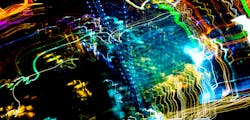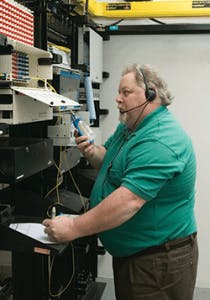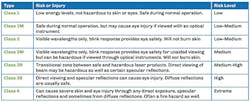Standards and Applications —
With fiber technology changing at a tremendous pace, it is critical that fiber optic safety be reviewed periodically. In all fiber optic communication systems, there are several areas of concern that affect those working with optical cables and transmission equipment. One of these, and that which we will focus on in this article, is the laser used in fiber optic transmitters and test equipment.
In today’s workplace, the issue of job safety has never been more important to the success of an organization. Litigation, lost productivity, and human costs, can take an enormous toll if safety is not considered. Fortunately, the role and use of the laser diode has been relatively safe due to the low optical power levels used, the safety features built into the transmission equipment, and the use of personal protective equipment and proper training. (See Figure 1.)
Figure 1. A technician is measuring the laser’s optical power level. (Courtesy of Light Brigade)
In this article, our goal is to review the laser diode and how it is used in fiber optic communication systems (FOCS) along with new challenges that must be addressed when implementing optical amplifiers used in long haul, dense wavelength division multiplexing (DWDM), and coarse wavelength division multiplexing (CWDM) systems.
Since the invention of the laser in 1960 by Ted Maiman at Hughes Research Labs, many types of lasers have been invented for various applications. From the earliest years, safety and standards organizations have been involved to address safety issues related to this technology. We will review the standards that specifically apply to FOCS.
In the US, lasers are regulated by the Center for Devices and Radiological Health (CDRH). A branch of the FDA, the CDRH is responsible for overseeing the manufacturing, importation, performance, and safety, of all devices that emit certain types of electromagnetic radiation, including cell phones, microwave ovens, and lasers. With lasers, the CDRH is concerned that the devices are properly labeled as to their output power, and that they are equipped with the appropriate safety equipment. It is the responsibility of the manufacturer to provide the correct classification of a laser, and to equip the product with appropriate warning labels and safety measures as prescribed by regulations.
A number of standards organizations have also developed standards and guidelines for safely working with optical fiber, cables, and optical transmission equipment. These include the ANSI Z136.2 American National Standard for the "Safe use of Fiber Optic and Free Space Optical Communication Systems Utilizing Laser Diode and LED Sources" along with OSHA’s laser safety standard STD-01-05-001.
For the lasers used in fiber optic communication systems and test equipment, the ANSI Z136.2 standard divides laser devices into a set of 4 general classes, and several sub-classes, based on their wavelength and optical power output. This standard was originally released in 1988, with the most recent version in 2012. This version addresses ribbon fibers, maximum exposure limits, and inspection methods.
Following is a summary of the 4 classes and a brief description of each. (See Figure 2.)
Figure 2. Laser Classifications chart (Courtesy of Light Brigade)
CLASS 1
A Class 1 laser system is considered to be incapable of producing damaging radiation levels during operation, and is exempt from any control measures or other forms of surveillance.
A Class 1M laser is incapable of producing hazardous exposure conditions during normal operation unless the beam is directly viewed through an optical instrument such as an eye loupe or a fiber inspection scope. For this reason, the "M" stands for Magnifying Optics Caution. Class 1M lasers are also exempt from control measures other than to prevent direct viewing of the beam through optical instruments. Fortunately, most of the fiber optic lasers used in communication systems are Class 1 types due to their low optical power levels.
CLASS 2
Class 2 lasers emit in the visible part of the spectrum between 400 and 700 nanometers. Eye protection is generally provided by a person’s natural aversion response to bright lights. The most common use of these lasers is the 1 milliwatt red laser tracers used by technicians for troubleshooting connectors, short runs (less than 1 km), and identifying macro and microbends.
Class 2M lasers emit in the visible part of the spectrum, and also rely on aversion responses for eye protection, but can be hazardous if viewed through optical instruments. The more powerful 5 milliwatt laser tracers are listed as class 2M devices.
CLASS 3
Class 3, or medium power lasers, is divided to 2 sub-classes: 3R and 3B. While the "B" has no special meaning other than a means of dividing Class 3 lasers, the "R" stands for Reduced Requirements. Class 3R lasers have reduced product safety requirements, and represent a transitional zone between safe and hazardous laser products. A Class 3 laser may be hazardous when directly viewed, and its specular reflection off a shiny surface may also be hazardous. Common examples include erbium doped fiber amplifiers (EDFA) and Raman optical amplifiers commonly used in long haul and DWDM systems.
CLASS 4
Class 4 lasers are higher power lasers with output that is a hazard to eyes or skin from the direct beam, specular reflections, and, in some cases, even diffuse reflections. Class 4 lasers often have sufficient optical power to be a fire hazard as well. A few of the higher optically amplified fiber systems using both Raman and EDFA amplifiers can be rated as Class 4 types.
The laser classifications relate specifically to the laser itself and its potential hazard, based on operating characteristics. However, the conditions under which the laser is used, the level of safety training of the individuals using the laser, as well as environmental and other factors such as optical multiplexing and ribbon fibers, are important considerations in determining specific safety control measures. (See Figure 2.)
Best Practices
Another important laser standard issued by the International Telecommunications Union (ITU) is the ITU-T G.664 Optical Safety Procedures and Requirements for Optical Transport Systems recommendation. This standard provides guidelines and requirements for techniques to enable optically safe working conditions on optical interfaces of the optical transport network including Raman amplification techniques in restricted and controlled locations while providing guidelines for automatic power reduction (APR) automatic laser shutdown (ALS), and automatic power shutdown (APSD) for systems employing high-power Raman amplifiers.
An example of APS is its use in FTTx Passive Optical Networks at the Optical Network Terminal (ONT) locations to shut down upstream laser transmission should the ONT’s connector be disconnected. The standard also covers optical safety procedures and requirements for optical transport systems critical for DWDM and other high-powered systems.
APR techniques are employed to reduce laser power to a safe level when there is a loss of optical continuity in the main optical path. This could be caused by a cable break, equipment failure, an unplugged connector, or similar occurrence. It is also recommended to use APR with automatic restart, and not with manual restart methods.
In addition, there is also IEC/TR 61292-4, Optical Amplifiers Part 4: Maximum permissible optical power for damage free and safe use of optical amplifiers. Besides addressing the maximum permissible exposure (MPE) for eyes and skin, this standard describes fiber damage caused by high optical power levels, connector end-face damage induced by dust/contamination. A key point in this standard is to address optical power limits that cause thermal damage and fiber-coat burn/melt induced by macrobends and microbends. This is critical to understand the impact of long haul, high data rate (>40 Gb/s), DWDM, and optically amplified systems.
Just the Beginning
Today, most FOCS optical signals are laser-based, and the potential risk of eye injury is determined by the output characteristics of the optical fiber system. Advancements have allowed modern optical communication systems to pose hazards significantly greater than those experienced in the past. This is why standards continually evolve to meet current needs, and safety programs should be reviewed and updated periodically to address new safety concerns.
This article deals with only one of many important safety topics related to fiber optics. In subsequent articles, we will be touching on the proper types of test equipment required to accurately and safely test transmitter power levels, along with alternate types of inspection equipment and personal protective equipment specifically designed for fiber optics. We will also address safe optical fiber handling, chemicals and right-to-know documentation, safety practices during installation and restoration, safety in confined spaces, and types of personal protective equipment.
About the Author



